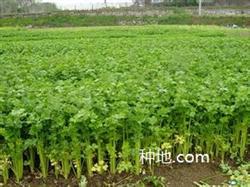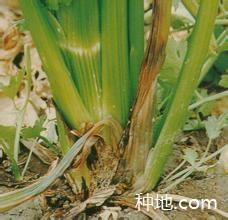What should I pay attention to when growing celery?

What do you need to pay attention to growing celery? There are the following technical points in planting celery: the commonly used sowing methods are dry seed direct seeding and soaking seed to accelerate budding sowing, dry seed direct seeding method is simple, seed buds are not easy to be damaged in adverse environment, but seedling emergence is slow; soaking seed to accelerate budding sowing, seedling emergence is faster and seedlings are uniform. Before sowing, the seedling bed was watered with enough bottom water, water permeated and then covered with a layer of fine soil, and the celery seeds mixed with fine sand were scattered evenly on the border surface. The fine soil covered with sterilization was 0.5 cm thick, and it was difficult to emerge seedlings if the soil was too thick, and the exposed humidity of the seeds covered with too thin soil was not difficult to germinate. Before sowing to seedling emergence, the soil should be kept moist enough to facilitate seedling emergence and seedling formation. The summer lunchtime temperature is too high, so you should sow seeds after 4 pm or on a cloudy day. After sowing, pay attention to ensure that the soil is moist, need a small amount of water to water frequently, watering too much to make the soil hardened, seedlings can not come out. The autumn sowing border also needs to be covered with a sunshade net, if the temperature is too high, the roof also needs to be covered. In the management of seedling stage from sowing to emergence, shading measures should be taken to avoid direct sunlight and prevent Rain Water from scouring. After sowing, a small bamboo arch is inserted on the border and covered with a sunshade net or straw. If only covering the sunshade net, it is better to have more than 2 layers. The experiment shows that the seedling emergence of rice straw is faster than that of sunshade net. When the seedlings come out, the sunshade on the border should be removed in time, and the surface of the border should not be too wet to prevent the seedlings from overgrowing. When the seedling grows to 1 leaf and 1 heart, the grass needs to be pulled once, and when the seedling has 3 leaves, keep the surface dry and wet and water, squat seedlings, cultivate strong seedlings, so that the growth of seedlings as consistent as possible. In case of rainstorm, stagnant water in the border should be eliminated in time to prevent seedling rotting root death or rotten seedling phenomenon. Celery likes to be wet, and the whole seedling stage should be watered frequently with small water. The watering time is usually carried out in the evening in the high temperature season. The principle is that the soil is wet and dry, and the soil condition is moist. The planting time can be chosen according to the local climate characteristics and the growth of seedlings. The plant can be planted when the plant height is 15ml 20cm, the stem is 0.5cm in diameter and the soil temperature is suitable. The distance between rows and plants varies with varieties and local cultivation habits. Generally, the plant spacing of western celery is 15 cm × 25 cm, and that of large celery is 35 cm × 30 cm. The specific planting density is carried out according to the local climate, soil conditions and cultivation habits. Water the seedling bed the day before planting, dig up the roots when raising the seedlings, shake off the soil and eliminate the sick and weak seedlings. When planting seedlings, the seedlings of the same size should be graded, and the seedlings of the same size should be planted together. The depth of the seedlings should be based on the depth of the seedlings in the nursery bed. Be careful not to cover the heart leaves and affect the growth. After the field management is planted, the management measures of early control and late promotion should be taken. After planting, the soil should be kept moist and watered or drained in time to slow down the seedlings. After the slow seedling is completed, the watering should be controlled, and the soil should be ploughed and weeded, and the squatting seedling should be carried out to promote the root growth and lay the foundation for the plant growth in the later stage. After squatting seedlings, the root system of the plant was developed and the absorptive capacity was enhanced. The leaf changes from open growth to upright growth, which is generally called the central stage. At this time, the outer leaves no longer increase, the heart leaves begin to develop, and the plants begin to enter the stage of hypertrophy and filling, at this stage, special attention should be paid to watering to ensure water supply, and nitrogen and potassium fertilizers should be applied at the same time to promote the growth of heart leaves and plant hypertrophy, which is the key link to increase yield. Therefore, after the end of squatting seedlings, immediately apply available nitrogen fertilizer, can also take nitrogen fertilizer and mature organic fertilizer. The first topdressing application of urea 20 kg per mu, after 10 days or so for the second topdressing, with watering per mu of human manure and urine fertilizer about 900 kg, and then half a month, urea can be applied again. In the process of topdressing, watch the weather and water in time to keep the soil moist. In the middle and later stage, in addition to nitrogen application, phosphorus and potassium fertilizer should also be increased. In addition, attention should be paid to the supply of calcium and boron. In order to promote the growth of celery and put it on the market early, gibberellin (920) can be sprayed on the leaves before harvest. More celery planting techniques
- Prev

How should celery be fattened?
What should I do if I want celery to increase production? The yield of celery could be increased by spraying gibberellin solution, which could promote cell division and growth, and the nutrient absorption reached the peak 8 hours after spraying. According to the experiment, the best concentration of gibberellin to promote the growth of celery is 0.004%-0.009.
- Next

What is the cause of celery petiole cracking?
Celery soft rot does great harm, how to effectively control celery soft rot? The prevention and control methods are as follows: 1. Crop rotation. Celery soft rot is mainly transmitted through soil, and a large number of bacteria are easy to accumulate in the soil of continuous cropping land, which is bound to cause and aggravate the disease. Therefore, the round should be carried out for more than two years.
Related
- Where is it suitable to grow horseradish in China? it is expected to see the middle altitude horseradish in Alishan.
- How to prevent tomato virus disease reasonably? (Control methods included)
- Many people like to plant towel gourd on the balcony. What are the main points of this method and management?
- What crops can chili peppers be mixed with?
- Fertilization techniques and matters needing attention in Tomato
- What are the grafting techniques for peach seedlings in spring?
- Harm and control methods of root swelling disease of Chinese cabbage
- What are the pests of sweet potatoes? How to prevent and cure it?
- Symptoms, causes and Control methods of navel Rot in Tomato
- The cause of "Cucumber rotten bibcock" in Farmers' planting Cucumber and its Control Plan

